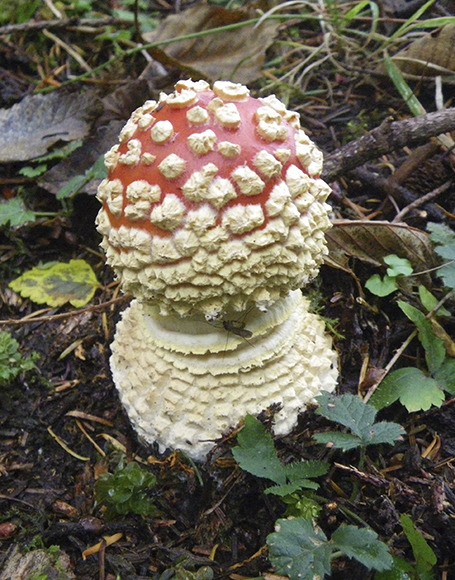By Russel Barsh and Madrona Murphy
A sure sign of autumn in the islands is the sudden appearance of large troops of mushrooms in lawns, fields, woodpiles, and woodlands. Heavy rain and cool but not freezing weather is ideal for a fall flush. But while overall good years are determined by the weather, individual mushroom species are unpredictable and may only be abundant once or twice in a decade.
Mushrooms are the fruits of some of the species of fungi in the phylla Basidiomycota and Ascomycota. Other fungi such as molds and yeasts do not produce fruiting bodies large enough for us to see, or to eat. Many fungi are parasites, and include diseases of humans such as ringworm and Pneumocystis pneumonia.
Most mushrooms we see are not poisonous, quite a few are edible and many are simply indigestible; very few are truly toxic. Many rely on small animals such as chipmunks to scatter their spores after eating the “fruit”: so they have to smell and taste good! Others attract insects such as gnats and midges to eat and bear off spores; they smell weird to humans but delicious to flies. Still other mushrooms simply rely on the wind to blow spores away to new ground, like the woody polypore mushrooms (they are inedible). Fungi have evolved effective attractants and deterrents for manipulating the behavior of animals!
What we see above-ground as a mushroom is tiny compared to the mycelium, the actual body of the organism, a sheet or web of highly organized, cooperating fungal cells that may be buried underground, or inside a log. Mycelia can live for centuries and grow to acres in extent. On the occasions when they fruit, their microscopic spores dust the ground surface around them, and fill the air like pollen. Few spores become new mycelia, however. Most land where conditions are not quite right, or other competing fungi are already established.
The main enemies of mushrooms are neither slugs nor the humans that somehow take pleasure in kicking them over, but rather the other fungi and bacteria that parasitize them. Over hundreds of millions of years, the fungi have developed a diverse chemical arsenal to ward off attacks by other microorganisms. We owe the first antibiotics such as penicillin (discovered in 1928) and erythromycin (1949) to wild strains of fungi.
Fungal diversity is directly and indirectly necessary for plant diversity. Directly, by forming underground mycorrhizal partnerships with plant roots through which the plant is fed micronutrients, and shares some of its sugars from photosynthesis. In old, relatively undisturbed woodlands, the entire forest floor may be underlain by layers of mycelia of a dozen or more fungal species, spreading out from the roots of the trees and shrubs with which they have formed partnerships. All terrestrial orchids, including the lovely pink Fairy Slippers, depend on soil fungi to feed their germinating seeds and to sustain the orchid throughout its lifetime. Our local evergreen orchid, Rattlesnake Plantain, reciprocates by sharing the products of photosynthesis with its fungal partner.
Clear-cut logging, heavy machinery treads, grading the soil surface, and forest fires can kill mycelia in the leaf litter, logs, and shallow soils, slowing the re-growth of trees and shrubs, and reducing the diversity of plant species and fungi that return. On Lopez, our greatest fungal and tree diversity is in south end woodlands with trees 200-600 years old. Dense but young secondary growth conifers, the dominant forest type on Lopez and generally 50-75 years in age, display less than half the diversity or abundance of fungi, although a few “decomposer” species, such as Black Morels, are specialists in disturbed soils. Most fungi are selective and will only work with one species of plant or a small number of related species. We are fortunate in the islands because many fungi prefer to form partnerships with Douglas firs. On Lopez Hill or Point Colville you can see white Short-Stemmed Russulas a foot or two in diameter emerging like fairytale toadstools around the trees. While this keystone mycorrhizal species is (at best) tasteless to humans it is considered delicious by squirrels and chipmunks. And it is often accompanied by less abundant species such as Shrimp Russula, Bleeding Lactarius, and Matsutake that humans find delicious.Indirectly, fungi are crucial in terrestrial ecosystems because they break down leaf litter and dead woody material, recycling nutrients to support new plant growth. You may have seen one of our most unusual, specialized decomposers, a tiny pale mushroom that only grows on fir cones! Many species can be found on fallen trees and stumps. These fungi have powerful enzymes that dismantle cellulose, lignin, and other structural compounds in wood; they also tend to have very useful properties as bio-degraders in bioswales. So raise a glass of wine (kvass, kumis, beer or kombucha will also do) to the fungi while eating some delicately sautéed local mushrooms on a piece of toasty bread in your home built with wood grown from mycorrhizal partnerships, and … you get the picture!
Kwiáht researchers are building an inventory of island mushroom species, their habitats and seasonality, to complement the annotated checklist and keys maintained by the South Vancouver Island Mycological Society, http://www.svims.org, with a focus on keystone habitat-building species, edibles, and dye-producers. Write kwiaht@gmail.com for more information.



